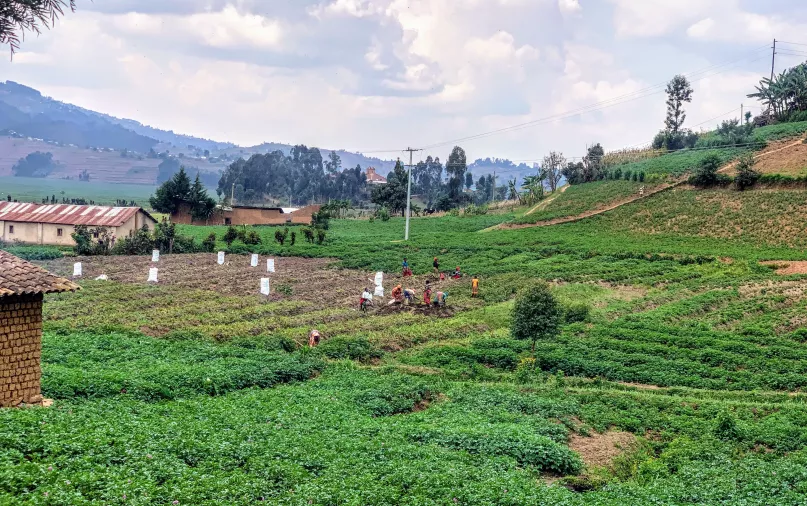What Do Microfinance Clients Need to Adapt to Climate Change?

Microfinance clients, especially smallholder farmers, are often at the front lines of climate change, their lives and livelihoods vulnerable to the impacts of rising temperatures, unpredictable rainfall and extreme weather events. Smallholder farmers are already experiencing firsthand the effects of climate change worldwide through decreased crop yield and production, higher pest and disease incidence, income generation constraints and, in some cases, food insecurity. In this context, we argue that microfinance institutions are well-placed to promote climate change adaptation products and services. However, there has been little research on whether they are doing so successfully.
To address this empirical evidence gap, our team of researchers at Glasgow Caledonian University and the University of Rwanda, funded by Opportunity International, has been developing a research program on how microfinance affects Rwandan smallholder farmers’ ability to adapt to climate variability. The study featured in this blog post was conducted between 2019 and 2021 with 400 participants in six Rwandan districts: three rural (Gisagara, Musanze and Ngoma) and three in the capital of Kigali. We did 30 in-depth interviews, 370 surveys (270 with smallholder farmers and 100 with agricultural produce traders) and transect walks with local community members.
Smallholder farmers found microloans and training helpful
As we talked to farmers, we learned that most have found microloans to be very useful in mitigating the impacts of climate change. The loans help them to make advance purchases of agricultural inputs, such as climate resilient high-quality seeds and fertilizer and pesticides, which they need to meet crucial crop cycle planting windows and face the increased threat of pests. Some farmers were also able to use the microloans to purchase water pumps and simple irrigation equipment to lessen the impact of floods and droughts on their plots.
Besides microloans, the other main intervention that smallholder farmers ranked highly was the training provided by MFIs. 98 percent of the 270 farmers surveyed reported that training was an essential component for building their capacity to adapt to climate change. Nearly all the farmers interviewed had been automatically enrolled in training programs organized by MFIs on the topics of financial management and agricultural productivity.
However, over one third of these farmers felt they still did not have the knowledge and skills needed to deal with erratic climate or climate change and asked for more advanced training opportunities. Specifically, they wished to gain more knowledge about ways to increase productivity through environmentally sustainable agricultural strategies that they can apply in their local contexts.
But some groups are excluded
Unfortunately, not everyone we spoke to had access to the microloans and training provided by MFIs. We found that farmers outside cooperatives and savings or trust groups (membership of which is a requirement for obtaining a loan) were at risk of missing these adaptation benefits. Excluded groups included vulnerable individuals such as:
- Young people, who were often unable to find capital to join such groups or provide collateral for individual agricultural loans.
- Some women, who were unable to take loans independently of their husbands.
- Farmers with less productive small hillside plots.
These inequities in access have potential to contribute to widening the already important gaps in financial inclusion, social equality and climate resilience between better-off farmers and those with fewer physical and human resources.
What else do farmers need?
Farmers had specific recommendations for improving their adaptive capacity, including changes to the purpose, scope, format and timing of microfinance loans. Fundamentally, farmers wanted more choice in loan use; they wanted to have the loan transferred directly to them instead of to agricultural input suppliers.
Other needs expressed by the farmers included:
- Government subsidies and loan terms that are better adapted to the purchase of environmentally sustainable agricultural inputs, such as fruit trees, which need longer crop cycles to return a profit.
- Bundled loan products with crop insurance, which has been recently introduced to Rwanda through public-private partnerships.
- Large-scale public and private investments in irrigation, energy and infrastructure for environmental protection, items not available for financing solely through microloans due to their high costs.
All these suggestions highlight the need to improve the coordination and linkages between key stakeholders - MFIs, government, development partners and environmental protection agencies -to ensure that national level policy commitments on climate change adaptation can be addressed in the field by the multiple entities involved in local development project plans and microfinance delivery.
Recommendations for MFIs
by incorporating effective climate adaptation practices into microfinance policy, programs and product design. Efforts should also be made to extend financial inclusion to those smallholder farmers most affected by climate variability, such as youth, women, those living on low incomes and those with small or no plots. Local MFIs, such as URWEGO Bank in Rwanda, have achieved this through partnerships with public and private graduation schemes and by offering non-secured loans. For example, URWEGO Bank initiated Village Savings Group loans in partnership with CARE International.
They can do so by:
- Offering a product range specifically tailored to local climate adaptation and mitigation needs.
- Adopting policies and programs that are sensitive to the needs of the most vulnerable.
- Proactively responding to the financial and social impacts of climate shocks through measures such as loan restructuring, as well as appropriate products and services such as climate emergency loans.
- Improving the coordination and linkages between key stakeholder policies and programs addressing financial inclusion and climate justice.
Microfinance can be a great tool to support smallholder farmers’ resilience to climate change. However, if not carefully designed it can also enhance existing inequalities leaving the more vulnerable groups behind. To avoid this, MFIs need to adapt their climate-proofed financial products to the local contexts and deliver them alongside high-quality non-financial services focused on climate adaptation.
The resources in this FinDev Guide explore the connection between financial inclusion and resilience and adaptation to climate change, through the lens of financial service providers, investors and policymakers.


